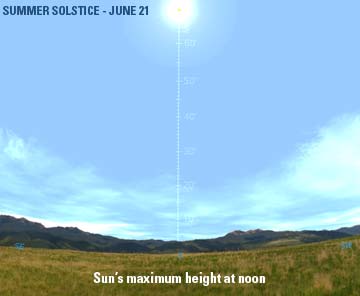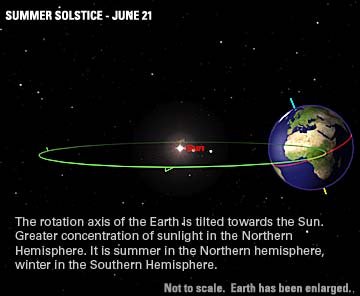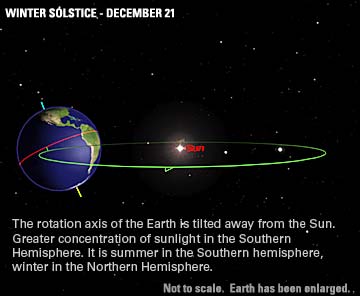
They started falling the moment I finished raking leaves in the back yard. Little frozen white stars. Snowflakes. For me, winter arrived this year on the fifth of November. For many folks, the first fall of snow signals the start of winter. But the calendar says otherwise. It says winter officially begins this year at precisely 7:22 p.m. EST on December 21. What's with that?
The winter solstice, that's what! It's a celestial event tied to the yearly orbit of Earth around Sun, and it is a linchpin of our calendar. "Without the practical benefits that astronomy supplied, it might not have been possible to have civilization at all," says Dr. E. C. Krupp in his book In Search of Ancient Astronomers. He goes on to explain that the calendar is, ?the device that permits complex organization of a culture, the device that rules the exchange of goods and services.? This is a powerful statement, but the calendar is a powerful influence on peoples and cultures. And the calendar is driven by the sky, with its daily, monthly and yearly cycles.
The summer and winter solstices are key reference points in our calendar, marking the yearly extremes of the Sun's changing height in the sky at noon. They serve as predictable markers for the swing of the seasons, neatly dividing the year into two equal halves. They bring a sense of order, place and continuity.
"Solstice" means literally "Sun stop." It is the exact moment in the year when the Sun reaches either its greatest northerly or southerly point in its annual motion. From these two points it "turns around" and heads the other way. Let's back up and explain things a bit.
The summer and winter solstices mark the respective maximum and minimum noontime heights of the Sun in the sky (Figures a and b).
The changing height of the noontime Sun through the year is a result of Earth's 23.5-degree tilt on its spin axis. As Earth moves around its orbit, first one and then the other hemisphere tilt toward the Sun (Figures c and d). The hemisphere tipped toward the sun experiences summer; the days are blessed with long hours of sunlight and the noon Sun climbs high in the sky. The hemisphere tipped away from the Sun experiences winter, with fewer daylight hours and a Sun that rides low across the sky.
The Sun reaches its minimum noontime height on the winter solstice. This is the shortest day of the year with the least amount of sunlit hours. As such, it also means there?s nowhere to go but up! After the winter solstice, the Sun is a little higher every day at noon. Each successive day has more sunlight — clearly, we're headed for spring! If that isn't good cause for celebration, what is?
It's no coincidence that Christmas and Yule celebrate the winter solstice. Ever since there have been people, there have been sky-watchers observing celestial cycles, noting special points in the year. The four chief markers are the two solstices and equinoxes. All over the world, people have marked and celebrated the solstices through time and across cultures. Many major festivals fall near these celestial events. Whether we realize it or not, our civilization is ordered around the happenings in the sky. With the winter solstice, we mark the beginning of the return to summer. It really is the season to be jolly!
 Figure a
Figure a
 Figure b
Figure b
The height of the noon Sun on the winter (a) and summer (b) solstices, as seen from 44 degrees north latitude. The actual height of the Sun above your local horizon depends on your latitude, but the total difference between the winter and summer height of the noon Sun, for all latitudes, is 47 degrees.
 Figure c
Figure c
 Figure d
Figure d
The seasons are caused by the tilt of the Earth. In the northern hemisphere it is summer when c) the northern hemisphere is tilted towards the Sun and it is winter when d) it is tilted away from the Sun. When it is summer in the northern hemisphere, it is winter in the southern hemisphere and vice versa.
All diagrams made with Starry NightŪ software.
December 2006















